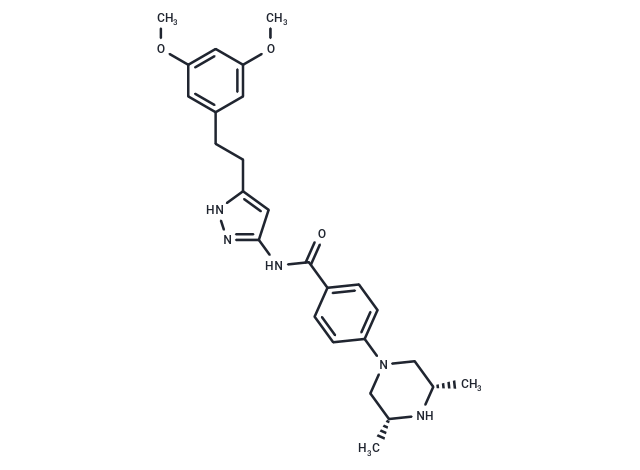Shopping Cart
Remove All Your shopping cart is currently empty
Your shopping cart is currently empty
AZD4547 is an FGFR family inhibitor. AZD4547 selectively inhibits FGFR1 phosphorylation and suppresses cancer cell proliferation through inhibition of FGFR1 signaling, and is able to act on FGFR1 (IC50:0.2 nM), FGFR2 (IC50:2.5 nM), FGFR3 (IC50:1.8 nM) and FGFR4 (IC50:165 nM). IC50:165 nM).[2]

| Pack Size | Price | USA Warehouse | Global Warehouse | Quantity |
|---|---|---|---|---|
| 2 mg | $33 | In Stock | In Stock | |
| 5 mg | $45 | In Stock | In Stock | |
| 10 mg | $57 | In Stock | In Stock | |
| 25 mg | $81 | In Stock | In Stock | |
| 50 mg | $115 | In Stock | In Stock | |
| 100 mg | $158 | In Stock | In Stock | |
| 200 mg | $230 | In Stock | In Stock | |
| 500 mg | $386 | - | In Stock | |
| 1 mL x 10 mM (in DMSO) | $50 | In Stock | In Stock |
| Description | AZD4547 is an FGFR family inhibitor. AZD4547 selectively inhibits FGFR1 phosphorylation and suppresses cancer cell proliferation through inhibition of FGFR1 signaling, and is able to act on FGFR1 (IC50:0.2 nM), FGFR2 (IC50:2.5 nM), FGFR3 (IC50:1.8 nM) and FGFR4 (IC50:165 nM). IC50:165 nM).[2] |
| Targets&IC50 | FGFR2:2.5 nM (cell free), FGFR1:0.9 nM (cell free), FGFR3:1.8 nM (cell free), KDR:24 nM (cell free) |
| In vitro | METHODS: NRK-52E cells were pretreated with 2.5, 5, 10, and 20 μM AZD4547 for 1 hour, and then exposed to 0.5 μg/mLLPS for the specified time, and the effect of AZD4547 on LPS-induced inflammation defects in NRK-52E cells was observed. RESULTS AZD4547 significantly inhibited cell proliferation in NRK-52E cells at a concentration of 20 μM. [2] METHODS: NRK-52E cells were pretreated with 10 μM AZD4547 for 1 hour and then exposed to 0.5 μg/mL LPS for the indicated time. The levels of proinflammatory factors in NRK-52E cells were studied. RESULTS AZD4547 attenuated LPS-induced inflammatory factors by reducing the TAK1/NF-κB signaling pathway in NRK-52E cells. [2] |
| In vivo | METHODS: C57BL/6 mice were treated with LPS (15 mg/kg, intraperitoneal injection) and AZD4547 (40 mg/kg gavage 1 hour before LPS treatment) to investigate the renal protective effect of AZD4547 in LPS-induced acute kidney injury. Expression of the pro-apoptotic gene Bax and the anti-apoptotic gene Bcl-2 was measured to investigate whether the effect of AZD4547 on preserving renal function in AKI is mediated by regulating apoptosis. RESULTS AZD4547 prevented LPS-related renal dysfunction, apoptosis, and renal inflammation in mice. [1] |
| Kinase Assay | Cells were treated with AZD4547 or control for 3 hours at 37°C and then stimulated with 10 ng/mL aFGF/bFGF and 10 μg/mL heparin for 20 minutes. Western blotting was conducted with standard SDS-PAGE procedures and antibody incubation carried out overnight at 4°C. Secondary antibodies were applied and immunoreactive proteins visualized with Chemiluminescence substrate according to the manufacturer's instructions [1]. |
| Cell Research | Cell lines were incubated with fixed concentrations of AZD4547 for 72 hours. For fluorescence-activated cell sorting (FACS), cells were fixed with 70% ethanol and then incubated with propidium iodide/RNase A labeling solution. Cell-cycle profiles were assessed with a FACSCalibur instrument and CellQuest analysis software. For apoptotic analysis, cells and media were gently harvested and centrifuged, followed by washing of cell pellets. Cells were then processed for Annexin V-fluorescein isothiocyanate (FITC) staining and propidium iodide uptake according to the manufacturer's instructions. The proportion of cells staining positive for Annexin V were then assessed with a FACSCalibur instrument and quadrant sorting was done by CellQuest analysis software [1]. |
| Animal Research | Tumor xenografts were established by s.c. injection into the left flank with 0.1 mL tumor cells (1 × 10^6 for LoVo, 1 × 10^7 for HCT-15, and 1 × 10^7 for Calu-6) or 0.2 mL (2 × 10^7 for KMS11 and KG1a) mixed 1:1 with Matrigel, with the exception of LoVo and HCT-15, which did not include Matrigel. Mice were randomized into control and treatment groups when tumors reached the determined size of more than 0.2 cm3. Tumor volume (measured by caliper), animal body weight, and tumor condition were recorded twice weekly for the duration of the study. Tumor volume was calculated as described previously [1]. |
| Molecular Weight | 463.57 |
| Formula | C26H33N5O3 |
| Cas No. | 1035270-39-3 |
| Smiles | COc1cc(CCc2cc(NC(=O)c3ccc(cc3)N3C[C@H](C)N[C@H](C)C3)n[nH]2)cc(OC)c1 |
| Relative Density. | 1.189 g/cm3 |
| Color | White |
| Appearance | Solid |
| Storage | Powder: -20°C for 3 years | In solvent: -80°C for 1 year | Shipping with blue ice/Shipping at ambient temperature. | |||||||||||||||||||||||||||||||||||
| Solubility Information | DMSO: 252.5 mg/mL (544.69 mM), Sonication is recommended. Ethanol: < 1 mg/mL (insoluble or slightly soluble) H2O: < 1 mg/mL (insoluble or slightly soluble) | |||||||||||||||||||||||||||||||||||
| In Vivo Formulation | 10% DMSO+40% PEG300+5% Tween-80+45% Saline: 2.5 mg/mL (5.39 mM), Sonication is recommeded. Please add the solvents sequentially, clarifying the solution as much as possible before adding the next one. Dissolve by heating and/or sonication if necessary. Working solution is recommended to be prepared and used immediately. The formulation provided above is for reference purposes only. In vivo formulations may vary and should be modified based on specific experimental conditions. | |||||||||||||||||||||||||||||||||||
Solution Preparation Table | ||||||||||||||||||||||||||||||||||||
DMSO
| ||||||||||||||||||||||||||||||||||||
| Size | Quantity | Unit Price | Amount | Operation |
|---|

Copyright © 2015-2025 TargetMol Chemicals Inc. All Rights Reserved.